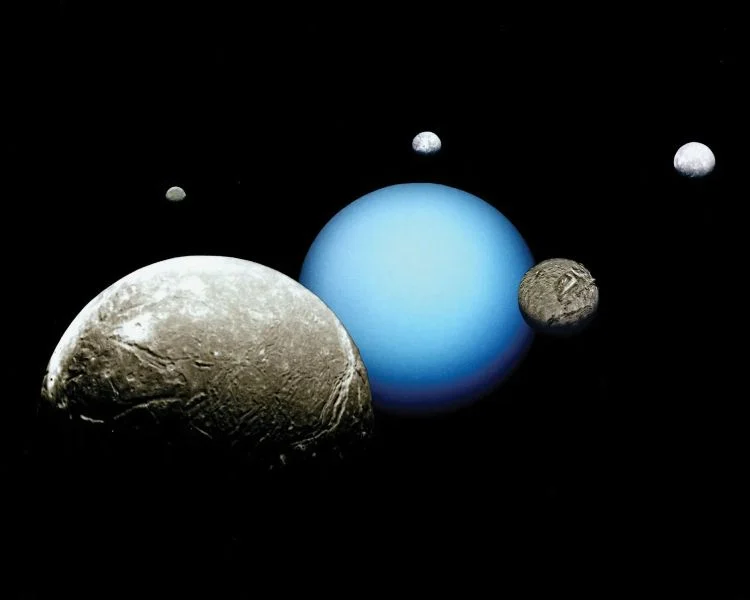
By Laurence Tognetti, MSc March 30, 2025
Collected at: https://www.universetoday.com/articles/uranus-moons-could-have-cryovolcanism-from-potential-interior-oceans
What can cryovolcanism on the dwarf planet Ceres teach us about potential cryovolcanism on Uranus’ five largest moons, which include Oberon, Umbriel, Ariel, Titania, and Miranda? This is what two studies recently presented at the 56th Lunar and Planetary Science Conference hopes to address, as a team of researchers investigated using Ceres as an analog for the potential ocean moons, Umbriel and Oberon, and the likelihood of an impact crater on Umbriel showing evidence of cryovolcanism. These studies have the potential to help researchers better understand the formation and evolution of ocean worlds in the outer solar system and whether they could potentially have life as we know it.
Here, Universe Today discusses this incredible research with Dr. Adeene Denton, who is a postdoctoral researcher at the Southwest Research Institute, and Dr. Jennifer Scully, who is a planetary geologist at NASA Jet Propulsion Laboratory, regarding the motivation behind the studies, significant results, cryovolcanism in the outer solar system, and how these studies could contribute to the discussion of sending another spacecraft to study Uranus and its moons. Therefore, what was the motivation behind the studies?
“When it comes to the Uranian satellites, there’s very little data, and what data we have is of relatively low resolution,” Dr. Denton, who is lead author on the impact crater study and co-author on the Ceres analog study, tells Universe Today. “NASA’s plans for its next Flagship mission are to (hopefully) return to Uranus, so now is the time for us to be thinking about targeting the different satellites as part of that mission. As part of that process, we need to better understand the geologic potential of some of the Uranian satellites – we know Miranda and Ariel could be of interest, but for Umbriel and Oberon, our image data is much poorer, which is part of the issue. Because Ceres happens to have geologic features that might be comparable, it’s an incredible opportunity to get some insight into these moons by leveraging what we know about Ceres.”

Credit: NASA
For Ceres analog study, the researchers compared cryovolcanism in Occator crater to potential cryovolcanism on Umbriel and Oberon using images obtained from NASA’s Dawn spacecraft and Voyager 2 spacecraft, respectively. The cryovolcanism on Ceres is depicted in bright spots that have been attributed to brine (extra salty) water with a potential origin being an ancient interior liquid water ocean. Similar bright spots were observed in the images of Umbriel and Oberon, so the goal of the study was to ascertain if Umbriel and Oberon possess, or once possessed, an interior ocean.
To accomplish this, the team analyzed the Voyager 2 images and compared the geological features of both moons to features on Ceres. The researchers attempted to enhance certain features in the Voyager 2 images to better compare them to the Dawn images, but the much lower resolution resulted in pixelation, or blurriness. Despite this, they were able to develop hypotheses regarding the bright spots’ origins on the Uranian moons while developing methods for future work with additional data.
For the Umbriel impact crater study, the researchers examined the approximately 130-kilometer (81-mile) Wunda impact crater on Umbriel with the goal of ascertaining if its bright spots are of cryovolcanic origin. They used a series of computer models to simulate the impact under various crust and ice shell thicknesses and possible subsurface liquid ocean. Therefore, what were the most significant results from the two studies?
“Our studies proposed two new hypotheses for these features in Umbriel and Oberon,” Dr. Scully, who is lead author on the Ceres analog study and a co-author on the impact crater study, tells Universe Today. “(1) Brines from a subsurface reservoir of melt, formed by the heat from the Wunda-forming impact, and potentially connected to a subsurface ocean, may have formed the bright deposit in Wunda crater, on Umbriel. The brines would have been pushed out onto the surface as the reservoir froze, leaving behind a bright salty deposit on the surface once the liquid component was lost to space.”
Dr. Scully continues, “(2) A slurry of brine and solid particles, also potentially sourced from a subsurface ocean, may have formed the unnamed mountain on Oberon as a cryovolcanic dome. Both hypotheses have direct analogs to features on Ceres: there are bright salty deposits in Occator crater (called the faculae) and Ahuna Mons is a cryovolcanic dome on Ceres.”
As its name implies, cryovolcanism is the ice version of traditional volcanism that consists of ice or frost in place of magma. First used in a 1987 Geological Society of America conference abstract, the term cryovolcano quickly gained traction, specifically since the Voyager 2 spacecraft had conducted a flyby of Uranus the previous year and was slated to conduct a flyby of Neptune the following year.
Before the scientific phase of the Voyager missions ended, Voyager 2 also revealed active geysers on Neptune’s moon Triton. Since then, more advanced missions have revealed the existence of active geological processes on several planetary bodies throughout the solar system, including Europa, Enceladus, Ceres, Pluto, and Titan. These findings continue to teach scientists that our solar system is in a diverse and active location in our small corner of the Milky Way Galaxy. Therefore, what can cryovolcanism in the outer solar system teach us about the formation of Uranus’ moons or even the solar system’s formation itself?
“Both of the processes we are suggesting for Wunda crater and Oberon’s mountain could be classed as cryovolcanism,” Dr. Scully tells Universe Today. “Adeene’s work modeling the formation of Wunda crater indicates that the ice shell of Umbriel may have been much thinner and/or warmer than it is today, which has important implications for the formation and evolution of this moon. Our work also shows that cryovolcanic processes could be triggered by impact cratering, as we suggest is the case for Wunda’s bright deposit. Impact cratering is a prevalent process across the solar system, so it is intriguing to think about it as a possible trigger for cryovolcanic processes.”
While Uranus continues to be studied to this day, especially by NASA’s powerful James Webb Space Telescope, the Voyager 2 spacecraft continues to be the only spacecraft to have directly visited Uranus and its many moons. Despite only conducting a flyby, Voyager 2 discovered 10 additional moons and two new rings around Uranus, which is the only planet in the solar system that orbits almost entirely on its side. Since its 1986 flyby, several missions have been in various stages of development from NASA, the European Space Agency (ESA), and the Chinese National Space Administration (CNSA), though many continued to be proposed, some were selected but never developed, and some not selected at all.
 Composite image of Uranus (center) with its five major moons obtained by the NASA Voyager 2 spacecraft (largest to smallest): Ariel, Miranda, Titania, Oberon, and Umbriel. (Credit: NASA/JPL)
Composite image of Uranus (center) with its five major moons obtained by the NASA Voyager 2 spacecraft (largest to smallest): Ariel, Miranda, Titania, Oberon, and Umbriel. (Credit: NASA/JPL)
These include ESA’s MUSE, ODINUS, and the joint NASA-ESA Uranus Pathfinder, CNSA’s Tianwen-4, and NASA’s OCEANUS and Uranus Orbiter and Probe (UOP). Of these missions, the 2023-2032 Planetary Science Decadal Survey selected UOP as a high priority Flagship-class mission, which are the most expensive and scientifically impactful missions, most of which whose costs surpass $1 billion. UOP is currently slated to launch no earlier than 2031 with orbital insertion around Uranus occurring in 2044. While UOP is still in development and could face design changes before launch, how do these two studies contribute to the discussion of sending another mission to Uranus, and should it be an orbiter or a flyby?
“If we go back to Uranus, we absolutely must do an orbiter,” Dr. Denton tells Universe Today. “To resolve the unknowns about the interiors of the moons, including the suggestions we have about their interiors being much more complex, we need to collect information at much higher resolution and ideally over multiple flybys – multiple flybys can give us the kind of geodetic/geophysical information we need to reconcile what we’re seeing on the surface with the deep interior (stuff like gravity data, using magnetic induction to detect the oceans, that kind of thing). If we’re serious about wanting to understand the Uranus system, committing to an orbiter is critical.”
Despite the limited data and direct exploration, the planet Uranus continues to be one of the most fascinating and mysterious planetary bodies in the solar system, including its sideways tilt and several moons boasting unique and awe-inspiring geological features that could indicate the existence of subsurface oceans, either in the past or present. While Voyager 2 was able to take advantage of a rare planetary alignment that happens only once every 175 years, enabling it to travel to Uranus in nine years, conventional methods would take almost 14 years to reach Uranus, as noted by the proposed UOP mission. While the enormous travel time is potentially one of the primary reasons for not returning to Uranus, these two studies demonstrate that there is still much to learn about Uranus and its many moons, including what it can teach scientists about planetary formation and evolution, and possibly even the history of the solar system.
“The Uranian moons are really cool,” Dr. Denton tells Universe Today. “I think this research is a cool example of taking old data from Voyager 2 and applying modern tools, including modern image data processing techniques and modern modelling efforts, to make the most of what we have. Science is a collaborative effort in the sense that we work in teams, but it’s also a collaborative effort in using any and all information we can. That’s the coolest thing about science, to me – that Voyager 2 can still keep helping us so many years later.”
What new discoveries about cryovolcanism in the outer solar system will researchers make in the coming years and decades? Only time will tell, and this is why we science!
As always, keep doing science & keep looking up!

Leave a Reply